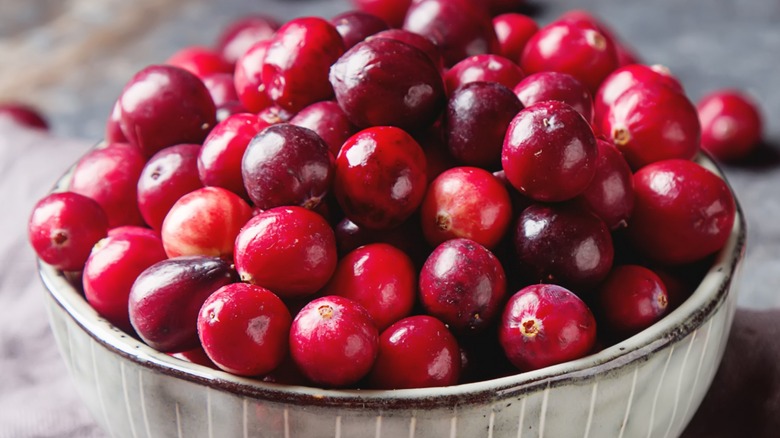What To Do When Your Fresh Cranberries Are Way Too Tart
Fresh cranberries probably don't end up on your weekly grocery list. Part of the reason may be due to their seasonality, but the other reason might have to do with a lack of knowledge on how to use these bright little berries. To be clear, fresh cranberries can be jarringly tart to the point where your mouth might twist and contort into a pucker. But, rather than entirely write off the ingredient, there are ways to get around the super sour nature of freshly harvested cranberries.
There are all sorts of cranberry products like canned jellies, bottled juices, dried fruit, or frozen treats available at the supermarket year-round. However, many of these processed goods tend to have a sweet edge that fresh cranberries don't. In fact, just-picked berries have a fairly acidic profile that can lean towards bitter given their concentration of astringent-presenting tannins. Since these qualities can make raw cranberries less than palatable, it's no surprise that the majority of all cranberries harvested are processed instead of being enjoyed fresh.
Yet, because fresh cranberries boast fruity, floral, and even woodsy layers of complexity, learning how to handle cranberries can be game-changing. That said, the best way to tackle fruits that are way too tart is to balance their sourness with sweetness. In addition to softening their abrasiveness, tossing any unbearably bitter berries with sugar can also heighten nuanced flavors. Who knew?
How to sweeten fresh cranberries for any recipe
Begin by washing and drying firm and shiny cranberries, before giving them a chop or slice. Then, coat them in the sweetener of your choice. Granulated sugar (white or brown) is a good option, but you can also experiment with other sweeteners. Anything from a drizzle of honey to agave, maple syrup, or molasses will also fare well. After a few minutes of maceration, the sour fruit juices will mix with the sugar and alleviate some of the cranberries' natural tartness. If necessary, strain the juices before snacking on them or using them in your next culinary creation.
While you can use the sweetened cranberries in a host of recipes, the key takeaway is that not a lot of sweetener should be added. Generally, a singular spoonful will be enough to offset sharpness without totally masking the cranberries' tangy profile. Briefly macerated berries can be used in savory recipes — perhaps worked into rich turkey meatballs, topped over melty cranberry and mint cheese crostini, or added to a delicate seafood crudo — as they'll maintain their acidic profile and harmonize with other contrasting flavors.
But, if you find that the sugared berries are still too tart for your liking, consider using fewer cranberries or reserve them for sweeter applications like jams, cakes, cocktails, or a savory cranberry sauce. Regardless of how you decide to showcase fresh cranberries, remember that incorporating some sweetness can transform even the tartest of fresh buds into something pleasantly delicious!

